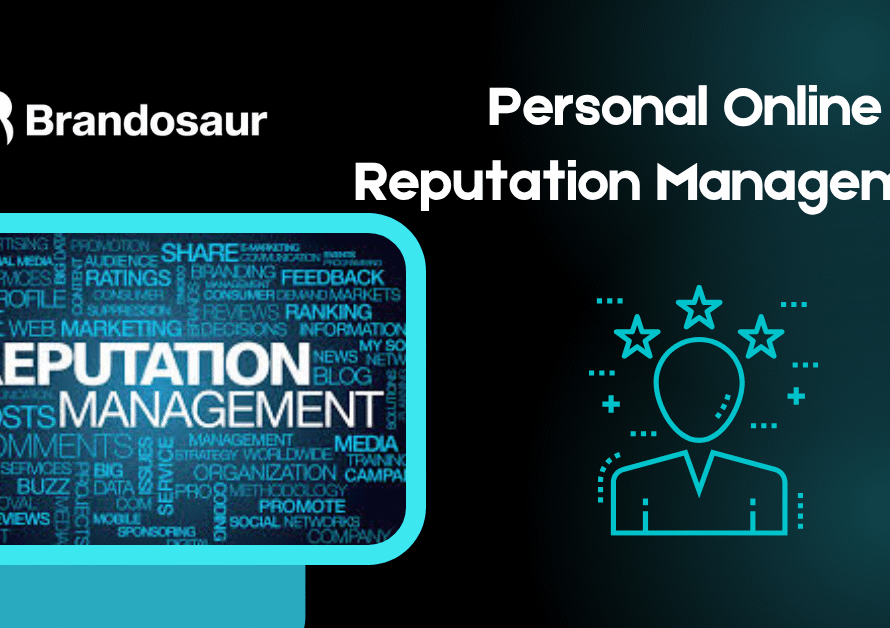Can you file an EB1A petition on your own?
- Brandosaur
- August 26, 2025
- 2:42 pm
Yes, unlike most employment-based visas, the EB1A petition explicitly allows self-petitioning. USCIS notes that for EB-1A (Extraordinary Ability) applicants, “No offer of employment or labor certification is required.” In fact, an applicant may apply for themselves by filing a Form I-140, meaning you can submit the petition without any employer sponsor. Immigration experts emphasize this point: the EB1A “classification is eligible for self-petition, so an applicant can apply on their own behalf.”
In practical terms, you do not need a U.S. employer or a job offer to apply. This makes EB1A unique among green card routes: it is designed for independent applicants of extraordinary accomplishment.
Before you begin, understand that extraordinary ability is a high bar. You must prove national or international acclaim (for example, a major award like an Oscar or at least 3 of USCIS’s 10 criteria). Make sure you truly qualify before investing time. (For a complete look at self-petition green card options, see Brandosaur’s Self-Petition Green Card Guide.)
- No Sponsor Needed: EB-1A explicitly allows you to petition yourself.
- High Standards: Gather strong evidence of your achievements (awards, media coverage, publications, etc.) that meet 3 of the 10 USCIS criteria.
- Required Forms: You’ll file Form I-140 (Immigrant Petition) indicating “extraordinary ability,” and later Form I-485 for adjustment of status (if in the U.S.).
- Time & Cost: Expect 8–15 months for USCIS to process I-140 (premium processing can shorten this to ~15 days). Filing fees (e.g., $715 for I-140 plus $2,805 for premium) are paid by you.
- Help if Needed: While self-filing is allowed, many applicants consult an attorney to ensure a rock-solid petition, since EB1A is very competitive.
Each of these steps is your responsibility, but it means you control the process. As one expert guide notes, “with the EB1A visa, you do not need a US job offer or a Labor Certification. Instead, you can apply for an EB1A visa by self-petition.” In short, you can handle your EB1A petition on your own; you just have to do all the legwork yourself.
What You Need to Know Before Starting a Self-Filed EB-1A Petition
Embarking on an EB-1A self-petition requires careful preparation. First, verify eligibility: USCIS demands either a single major award (Nobel, Olympic Medal, etc.) or proof of at least 3 of 10 criteria (such as published articles about you, patents, leading roles, high salary, etc.). Then, gather documentation: collect items like award certificates, media clippings, publications, association memberships, and expert letters that clearly demonstrate your acclaim. Before filing, consider these key points:
1) Evidence Checklist
Review USCIS’s EB-1A criteria carefully. You’ll need strong evidence for each claim. For example, if you claim “judging the work of others,” include proof like award-giving or conference panel invitations. If “original contributions” include patents or citations.
2) Recommendation Letters
Plan to obtain 4–6 reference letters from independent experts or mentors. These letters (often from professors, bosses, or industry leaders) should specifically attest to your extraordinary ability. Brandosaur notes that “strong expert reference letters are often crucial” and can be among the most persuasive evidence.
3) Forms & Procedures
You will file Form I-140 (Immigrant Petition) as your own sponsor. Check the latest USCIS instructions on filling it out. Also, prepare Form ETA-750 if needed (though EB1A does not require PERM labor certification). If you are adjusting status in the U.S., you’ll later file Form I-485. If abroad, prepare for consular processing. (Brandosaur’s EB1A Application Process Guide has a helpful timeline of each step.)
4) Timeline
Realize the process can take a year or more. After filing I-140, USCIS may request more evidence (RFE); responding promptly is your job. Once I-140 is approved, the wait for a green card (via I-485 or visa processing) could be several more months.
5) Be Thorough
Double-check all forms and evidence. Even minor errors can cause delays. Use the latest USCIS forms and sign everything. According to Brandosaur, “a single accomplishment isn’t enough” – USCIS looks for a consistent track record.
Before you dive in, consider consulting resources like Brandosaur’s guides or seeking a free evaluation. Knowing exactly what USCIS expects will save you trouble later. For step-by-step guidance, see the EB1A Profile Building guide on strengthening each criterion.
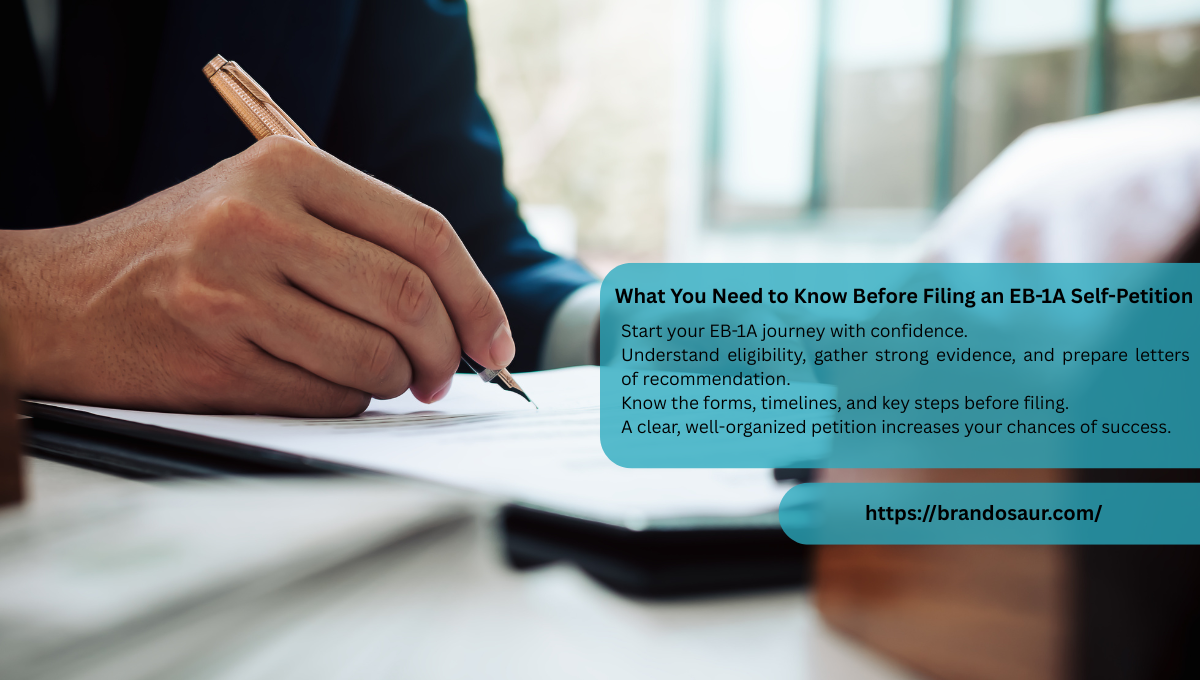
Filing an EB1A Petition on Your Own: How to Take Charge of Your Immigration Journey
Filing independently means taking charge of every detail. Start by creating a plan: outline your achievements and match them to USCIS criteria. Then gather evidence methodically. You might organize folders or a checklist for each category (Awards, Publications, Media, etc.). Develop a clear petition letter that narrates your career highlights and links them to the evidence you’ll submit.
1) Document Your Excellence
Organize proof of each criterion. For example, under “Memberships,” include certificates and association info; under “Original contributions,” include patents or peer citations. Brandosaur advises structuring exhibits by category and clearly labeling each item.
2) Write a Strong Petition Letter
Your cover letter (or petition letter) should tie your entire case together. Summarize your qualifications, list the criteria you meet, and explicitly reference your supporting documents. This ensures USCIS officers see how your evidence demonstrates extraordinary ability.
3) File Form I-140
Complete the petition form, marking “extraordinary ability.” Include all fees and supporting docs. If you qualify, consider adding Premium Processing (Form I-907) to expedite the decision (about 15 days). Premium is optional but can greatly shorten wait times.
4) Maintain Records
Keep copies of everything you send. Organize your files so you can quickly find any document if USCIS has questions. As Brandosaur suggests, “keep detailed records of all your achievements” so you can support every claim.
5) Follow Up
After filing, track your receipt number on the USCIS website. If an RFE arrives, respond fully and on time; this is critical. If approved, you’ll handle the next steps (I-485 or consular processing) on your own or with family.
By doing it yourself, you stay fully informed. You’ll know exactly what went on in your case and why. This control can be empowering; you are literally guiding your path to a green card. If you ever feel unsure, Brandosaur offers consultations and resources like their Application Process Guide that outlines each filing step.
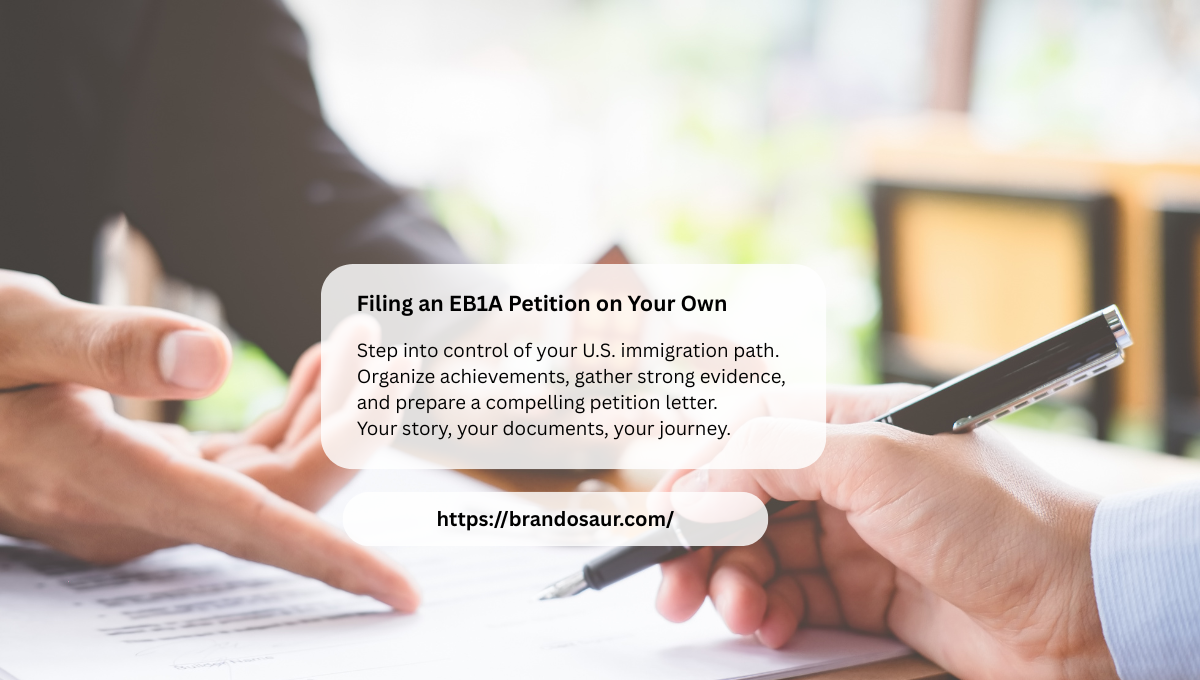
EB1a petition vs. Employer Sponsorship: Which Path Suits Your Immigration Goals?
Feature | Self-Petition (EB-1A) | Employer-Sponsored (EB-1B/EB-1C) |
Who Can Petition | The applicant themselves files Form I-140. | A U.S. employer files an I-140 on your behalf. |
Job Offer Required | No, EB-1A explicitly does not need a job offer or labor cert. | Yes, EB-1B (professors) and EB-1C (managers) require a permanent job offer from the employer. |
Documentation Emphasis | Extraordinary achievements and recognition (awards, media, original contributions, etc.). | Your work at the sponsoring company (research publications, leadership roles) plus credentials (Ph.D., 3+ years of experience). |
Control & Flexibility | High control: you choose evidence and timing. | Less flexible: the process depends on the employer’s timing and priorities. |
Path | EB-1A visa, leading to a green card for you (and family). | EB-1B (Outstanding Researcher/Professor) or EB-1C (Multinational Manager) also leads to a green card. |
When to Choose | Best if you clearly meet EB-1A criteria (top awards, global acclaim) and want independence. | Best if you have a qualifying job (e.g., tenured professor or global manager) and a company to sponsor you. |
As Manifest Law explains, “EB-1A allows for self-petitioning without a job offer, while EB-1B and EB-1C require U.S. employer sponsorship.” In other words, if you have the rare credentials (international awards, publications, fame) and no employer sponsor, EB-1A is likely your route. If instead you’re in academia or have worked for a multinational company, your employer might steer you toward EB-1B (as an outstanding researcher) or EB-1C (as an executive). Both ultimately yield green cards, but they come with sponsorship conditions.
Ultimately, the “best” path depends on your situation. Independent filing (EB-1A) gives you control and is ideal if you strongly meet the extraordinary criteria. Employer-based routes may be simpler if your work falls squarely into their categories and you have institutional support.
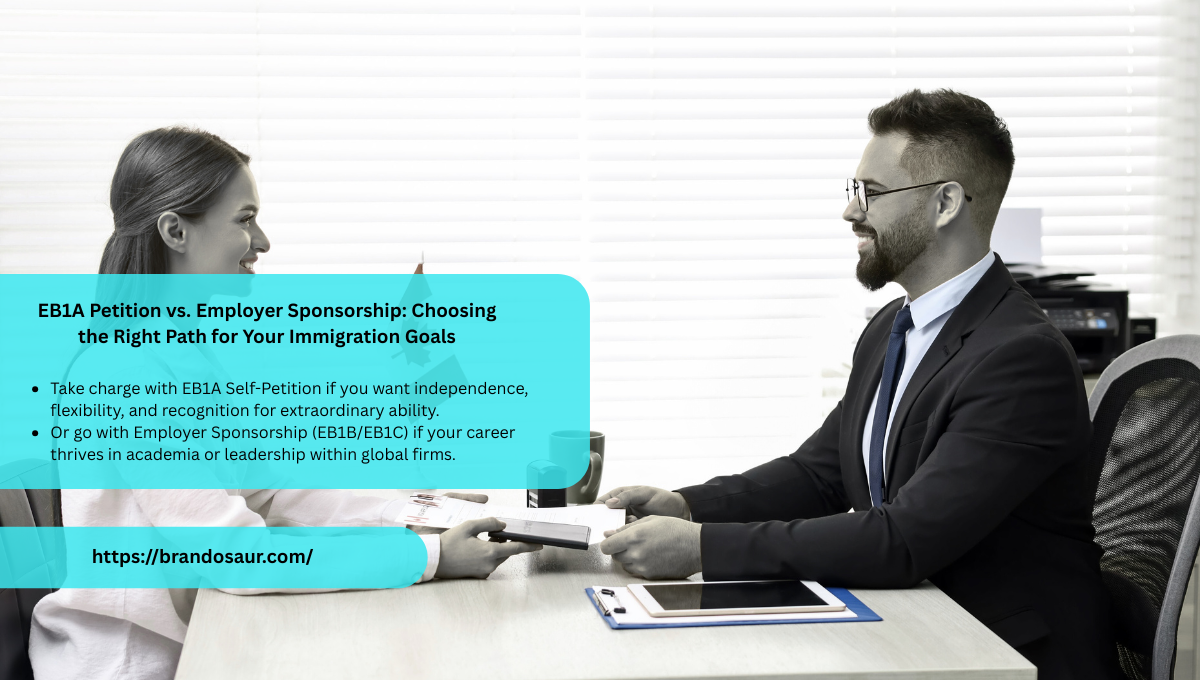
Employer-Sponsored EB1A Petition: How Strategic Partnerships Can Strengthen Your Case
Yes, even though EB-1A doesn’t need a sponsor, partnering with employers or organizations can enhance your petition. Think of strategic partnerships as endorsement networks: you can include letters and documents from employers, mentors, or partners to reinforce your case. For example:
1) Recommendation Letters from Employers
Ask current or former supervisors to write detailed letters highlighting your role. A boss can explain how your contributions (to projects, patents, or business success) meet the “original contributions” or “leadership” criteria. Brandosaur notes that letters from respected independent experts are “often crucial” to EB-1A. A letter from an employer can serve as one such expert testimonial.
2) Collaborative Achievements
If you’ve led major projects at work or co-authored research, document those achievements. A certificate of completion or a press release about a joint venture can illustrate your influence in the industry.
3) Affiliation with Renowned Institutions
Listing membership in prestigious organizations (e.g., IEEE, Nobel committee, top journals) ties you to top peers. These associations often require employer/peer nominations to join, effectively showing your network’s support.
4) Consider Employer Filing (If Applicable)
If your employer is willing, they might sponsor you under EB-1B or EB-1C. Even if you pursue EB-1A, the preparation for an employer petition (like financials and job descriptions) can highlight your standing.
The idea is to leverage relationships to make your self-filed petition stronger. While the EB-1A petition itself is filed in your name, documentation from a recognized organization or company can validate your claims. For example, if a university department files an I-140 for you as a researcher, that’s EB-1B, but a similar endorsement letter from that department can boost an EB-1A case.
Remember: the question is EB1A vs employer-sponsored. You cannot technically have an “employer-sponsored EB-1A.” Once an employer files, it becomes EB-1B or EB-1C. But if you choose EB-1A, you can still include employer or peer letters as evidence, making your petition as strong as if it had institutional backing. For tips on writing powerful recommendation letters, see Brandosaur’s Letter of Recommendation Guide.

EB1A Petition: When It Makes Sense to File Independently vs. Relying on Employer Support
Which option fits your goals?
File Independently (Self-Petition EB-1A) if:
- You have clear, documented extraordinary achievements (major prizes, high-impact publications, and leadership awards) that stand on their own.
- You want flexibility; for instance, if changing jobs or freelancing, you won’t be tied to an employer.
- You prefer to control the timeline and content of your petition.
- You do not have an employer lined up to sponsor EB-1B/EB-1C, or you prefer not to depend on one.
Seek Employer Support (EB-1B/EB-1C) if:
- You work in academia or research with strong evidence (tenure offer, cited work), but maybe less global recognition. EB-1B might be easier if a university wants to sponsor you.
- You are a high-level manager in a multinational and meet the EB-1C criteria (one year abroad, leading a U.S. branch).
- You have a supportive employer willing to handle the petition (less paperwork for you personally).
- Your achievements are impressive, but might be better validated by an employer’s documentation (like patented inventions at a company).
Consider your career path: an independent EB-1A lets you present yourself to USCIS as a standalone star. Relying on an employer can be easier if you fit those other categories, but it means your green card hinges on that job. Consult guides and perhaps an attorney; many applicants use both approaches (e.g., prepare an EB-1A and an EB-2 NIW) to maximize chances.
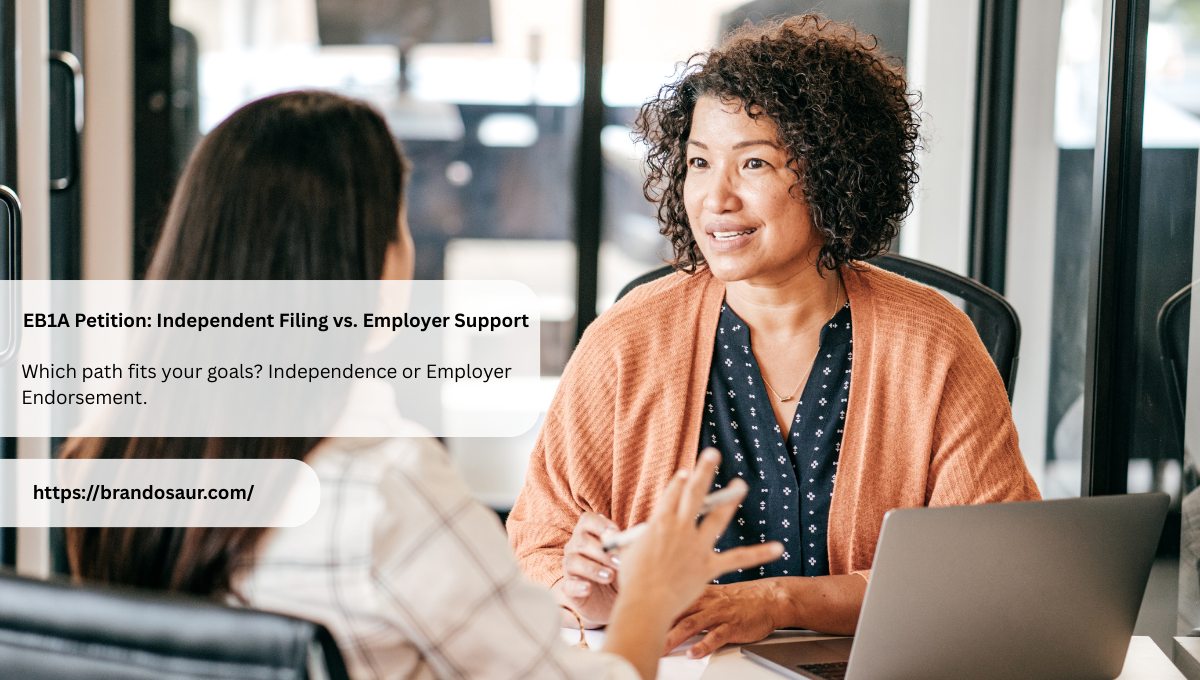
Straight Talk: Yes, You Can Handle Your EB-1A petition Independently
Self-filing an EB-1A petition is challenging but entirely doable. Thousands of applicants each year succeed on their own. In Brandosaur’s self-petition guide, they report that over 40,000 green card applications are filed annually by individuals without sponsors (including EB1A, EB2-NIW, etc.). You can be among them if you meet the criteria.
Here are some practical tips:
- Be Organized: Use checklists and timelines. Track deadlines and responses. A neat, clearly labeled petition is easier for USCIS to review.
- Focus on Quality: Ensure every piece of evidence directly supports a criterion. It’s better to have a few compelling documents than many loose items.
- Use Resources: Read USCIS policy (see USCIS Policy Manual on EB-1A), brandosaur’s EB1A guides, and other expert blogs. These fill in details that general advice might miss.
- Know When to Ask for Help: Even if filing yourself, consider at least consulting an immigration attorney or mentor before submission. Small mistakes can derail a case.
Above all, maintain confidence: “Yes, EB1A is explicitly designed for self-petitioning. You do not need an employer; you file Form I-140 on your own behalf.” Prepare thoroughly and speak to any consultants or attorneys you trust for a final review. With the right evidence and presentation, your independently-filed EB1A petition can succeed just like a sponsored one.
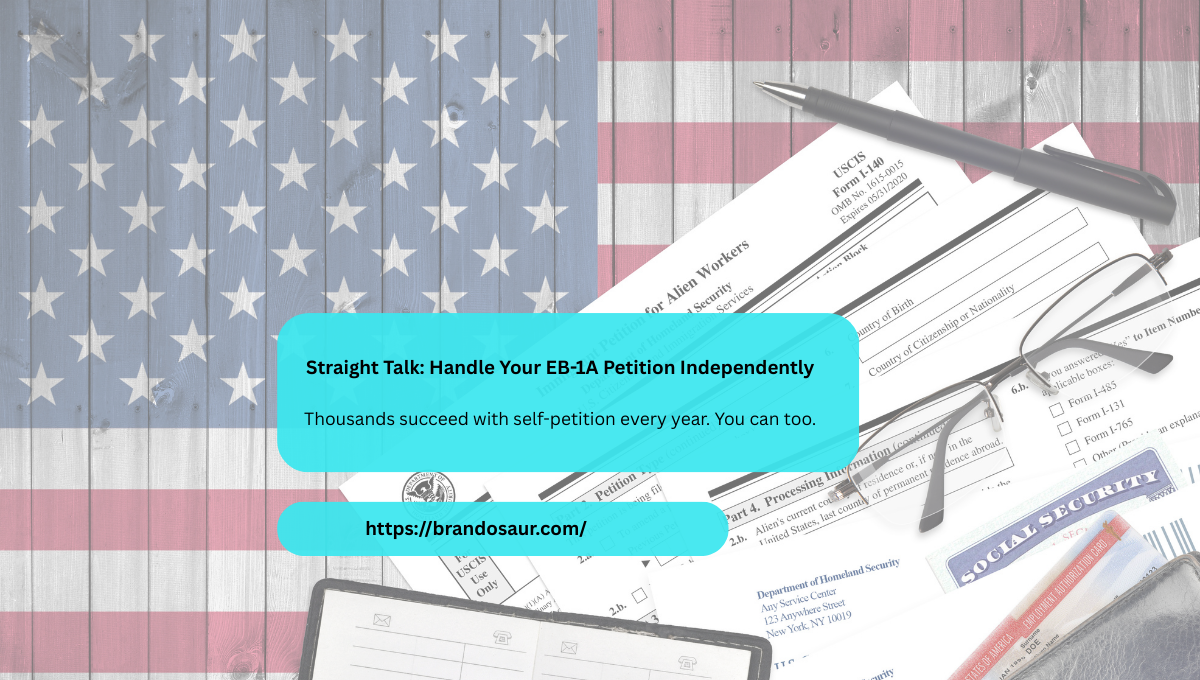
FAQs
Q1: Can I petition for EB-1A without an employer?
Ans: Yes, EB-1A is a self-petition category. USCIS confirms “no offer of employment or labor certification is required”, meaning you can file Form I-140 yourself.
Q2: What evidence do I need for EB-1A?
Ans: You must show “extraordinary ability” via either a one-time major award (Nobel, Oscar, Olympic medal, etc.) or at least 3 of the 10 USCIS criteria (like international prizes, scholarly articles, judging others’ work, original contributions, etc.). Gather documentation (awards, publications, media coverage, etc.) for each criterion you claim.
Q3: Is having a job offer better or worse?
Ans: For EB-1A, a job offer is not needed and does not affect eligibility. Whether to secure one depends on your situation. If you qualify strongly on your own, you don’t need an offer. If you have an employer willing to sponsor you under EB-1B or EB-1C, that’s a different path (and may be simpler in some cases).
Q4: How long does the EB-1A process take?
Ans: Typically, USCIS adjudicates an EB-1A I-140 petition in about 4–7 months (regular processing). Premium processing can speed it up to 15 days. After I-140 approval, adjusting status (I-485) or visa consular processing usually takes another 6–12 months. Total time is often 8–24 months, depending on the service center and visa availability.
Q5: Do I need an attorney to file EB-1A?
Ans: Not legally, but EB-1A petitions are complex. Many choose an immigration attorney for help preparing a strong case. An expert can catch gaps in evidence and ensure forms are correct. If you do it alone, double-check everything (forms, fees, evidence) carefully, or consider a consultation to review your petition before you submit.
Q6: What happens after my EB-1A I-140 is approved?
Ans: Once USCIS approves your I-140, you apply for your green card. If you are in the U.S., you file Form I-485 (Adjustment of Status). If abroad, the case goes to the National Visa Center, and you complete consular processing. Your spouse and unmarried children (under 21) can get green cards too.




